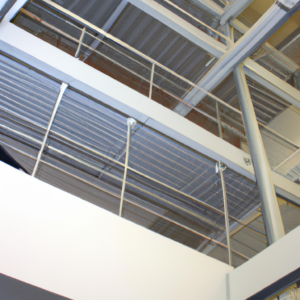In the ever-evolving landscape of modern business, effective space utilization holds the key to efficiency and growth. As companies expand and operations become more complex, the need for additional space within existing premises becomes inevitable. This is where the ingenious concept of mezzanine floors comes into play, revolutionizing the way we view workspace optimization.

Understanding Mezzanine Floors
Mezzanine floors, in their essence, are intermediate levels constructed within a building to create additional usable space between the floor and ceiling. They bridge the gap between the main floors, providing an innovative solution for adding square footage without the need for extensive construction. Mezzanine floors can be freestanding structures or integrated into the existing framework, offering flexibility in their application.
Benefits of Mezzanine Floors
The allure of mezzanine floors lies in their multifaceted advantages. Financially, they present a cost-effective alternative to constructing new buildings or leasing additional space. By capitalizing on vertical space that might otherwise go unused, businesses can optimize their operations without a significant increase in overhead costs. Additionally, mezzanine floors offer a swift installation process, minimizing disruptions to ongoing activities.
Types of Mezzanine Floors
Mezzanine floors come in a variety of types, each tailored to specific needs and preferences. Structural options include rack-supported mezzanines, perfect for warehousing, and beam-supported mezzanines that provide sturdy platforms for heavy machinery. Materials range from steel to aluminum, with choices for flooring surfaces to suit diverse requirements.
Design and Construction
Designing and constructing a mezzanine floor requires careful consideration of various factors. Load-bearing capacity, safety measures, and adherence to building codes are pivotal aspects. Modern mezzanine designs incorporate cutting-edge technology to ensure optimal load distribution and structural integrity. The process involves meticulous planning, engineering expertise, and the integration of safety features like railings and fire protection systems.
Space Optimization Techniques
The strategic integration of mezzanine floors holds the key to unlocking unutilized vertical space. These structures can transform cramped areas into functional workspaces, storage zones, or even retail displays. Imagine a warehouse that doubles its storage capacity by installing a mezzanine level or an office that gains extra meeting rooms without expanding its footprint. Mezzanine floors allow businesses to scale up without the traditional spatial constraints.
Applications in Various Industries
The adaptability of mezzanine floors transcends industries. In manufacturing, they offer room for assembly lines and equipment storage. Warehouses utilize them for increased storage capacity, efficiently stacking inventory both below and above. Office spaces benefit from added meeting rooms or breakout areas. The hospitality sector employs mezzanine designs to create captivating visual elements, like elevated dining spaces in restaurants.
Customization and Flexibility
Mezzanine floors are not a one-size-fits-all solution. They can be customized to align with specific operational needs. Whether it’s adjusting the layout, incorporating modular offices, or integrating specialized equipment, customization ensures that mezzanine floors seamlessly integrate with existing workflows. This adaptability extends their lifespan as businesses evolve.
Safety Measures
While mezzanine floors bring expanded space, safety remains paramount. Compliance with safety regulations and adherence to building codes are non-negotiable. Features such as guardrails, fire protection, and proper lighting are integral components of a secure mezzanine environment. Investing in safety ensures the well-being of employees and safeguards against potential liabilities.
Return on Investment (ROI)
One of the most compelling aspects of mezzanine floors is their remarkable return on investment. The relatively lower construction costs, rapid installation, and heightened space efficiency contribute to a favorable ROI. The additional space generated by mezzanine floors can lead to increased productivity, streamlined workflows, and ultimately, higher revenue generation.
Environmental Impact
In an era of heightened environmental consciousness, mezzanine floors offer an eco-friendly solution. Compared to new construction, which often requires extensive resources and energy, mezzanine installations repurpose existing space. This reduction in material consumption and waste aligns with sustainable business practices, making mezzanine floors a responsible choice.
Challenges and Considerations
Integrating mezzanine floors into existing spaces requires careful planning. Local building codes, permits, and structural assessments must be navigated diligently. Additionally, businesses must consider factors such as accessibility, aesthetics, and potential disruptions during installation. Overcoming these challenges demands collaboration between architects, engineers, and business owners.
Case Studies
Numerous businesses have harnessed the potential of mezzanine floors to transform their operations. An e-commerce warehouse increased its order fulfillment capacity by 50% through a mezzanine expansion. A tech startup optimized its office layout, accommodating a growing team without relocating. These real-world examples underscore the adaptability and transformative impact of mezzanine floors.
Future Trends
As workspace dynamics continue to evolve, mezzanine floors are poised to remain a central player. Future trends indicate an increased focus on modular mezzanine designs, seamless integration of technology, and the incorporation of sustainable materials. The ability to swiftly adapt spaces to changing needs positions mezzanine floors as a cornerstone of innovative workspace solutions.
Conclusion
In the pursuit of efficient space utilization, mezzanine floors emerge as a game-changing strategy. By expanding upwards, businesses can avoid the limitations of horizontal expansion and unlock untapped potential within their existing structures. From manufacturing to hospitality, mezzanine floors empower enterprises to scale intelligently, increase productivity, and maximize returns. Embracing the power of mezzanine floors is a strategic investment in the present and a visionary step into the future.




